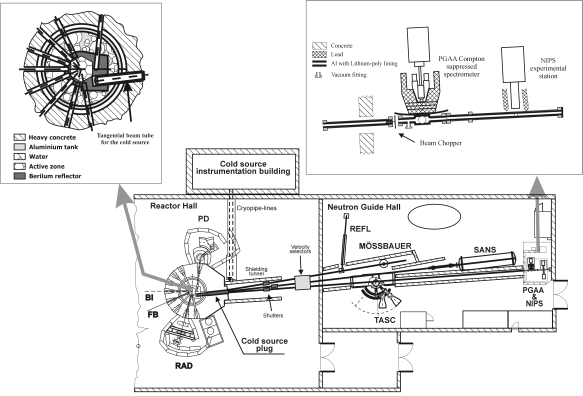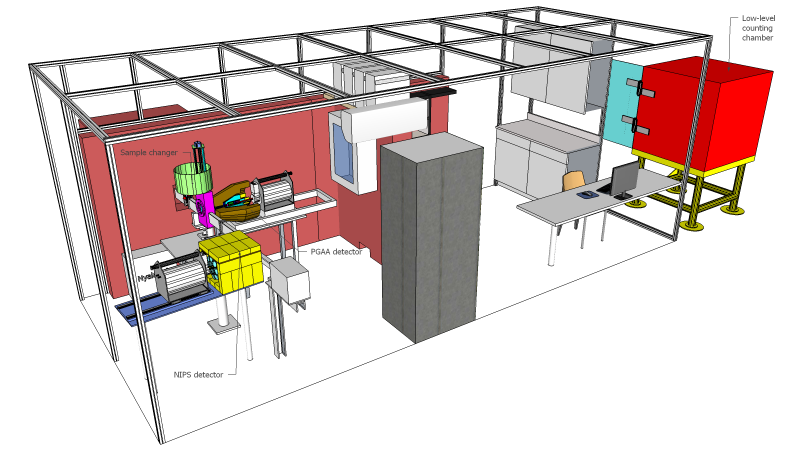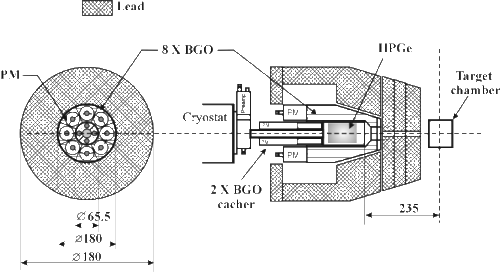Prompt-gamma activation analysis
Introduction
Prompt gamma activation analysis (PGAA) enables a non-destructive analysis of elemental composition by observing neutron-capture prompt gamma rays. The thermal-neutron PGAA facility at the Budapest Research Reactor was operating from 1996 to 2000.
In 2001, a
liquid hydrogen containing cold neutron source was installed
in the reactor. Part of the neutron guide system was also reconstructed
at the same time. Due to these modifications the neutron flux increased
more than an order of magnitude. The neutron beam at the end of guide
was split and now serves two facilities. The PGAA facility is dedicated
to the routine chemical analysis. A beam chopper was installed
in 2005, which adds some time information to the gamma
measurements.
In 2007, thanks to the
replacement of 12 m neutron guide, the neutron flux at the sample
position was increased to 1.2x108 cm-2s-1.
Beam line
The experimental area located in the neutron guide hall, attached to the Reactor building. PGAA experimental station is a 3x5m2 place at the end of guide No. 1.

The top view of the Budapest Research Reactor, the neutron guide hall and the PGAA-NIPS facilities.
The neutron guides are surrounded with a biological shielding made of concrete. The whole experimental station is enclosed in a cabin made of iron screening, facilitating stable and low-noise operation of the detectors and electronics. The neutron beam is collimated into two sub-beams and can be operated separately. The sample chambers are located in a sectioned beam tube made of aluminum that can be evacuated. The chamber is lined on the inside with slow-neutron absorber made of a 6Li containing plastic sheet. The sample chamber used for prompt gamma neutron activation analysis is at a distance of 1.5 m from the guide end and 37 cm from the chopper. The neutron beam can further be collimated at the entrance of the chamber using a set of neutron collimators with cross sections from 400 down to 5 mm2. The second neutron beam passes below the PGAA sample chamber to the NIPS station. The two beams are separated with a neutron absorber sheet. The beam stops at the end of both beams are made of 6Li-containing material surrounded by lead bricks.

The 3D view of the PGAA-NIPS facilities.
Samples
The sample can be solid, powdered, liquid or even gaseous. The typical sample weight is between few hundreds of milligrams and a few grams. Small samples, after being heat-sealed into Teflon bags if needed, are fastened with Teflon strings onto an aluminum frame. This can be put perpendicularly, parallel or at an angle of 30° to the beam direction. The maximum size of the sample that fits into the chamber is about 5x5x5 cm3, though the observed volume is about 10 cm3. Even larger objects can be irradiated after removing a section of beam tube.
Gamma-ray detection
The gamma radiation emitted by the sample reaches the HPGe detector through a 10-cm long, 2-cm diameter lead collimator. The sample to detector distance is kept at 235 mm, which is large enough to minimize the effect of peak summing. The BGO Compton-suppressed HPGe detector system covered by 10-cm thick lead shielding.

The back and the cross-sectional view of the PGAA Compton-suppressed detector.
The neutron and gamma shieldings were designed to ensure an environment with the lowest achievable radiation level. The room background in the spectrum is about 0.5 cps, while the beam background is 13 cps when both beams are open and 10 cps when only the upper of them is operating. The background peaks have been carefully identified in a series of measurements.
The calibration of the full-energy-peak efficiency is done with common radioactive sources and (n,gamma) reactions, covering the energy range of 20 keV to 11 MeV. Its accuracy is better than 1% from 50 keV to 8 MeV. A chopper can also be installed optionally to examine the neutron spectrum or the decay gamma rays of short-lived nuclides. The chopped beam PGAA technique combines the advantages of the in-beam measurement and the simplicity of decay gamma spectra.
Conclusions
The PGAA facility is a proper tool for routine analysis and for the investigation of radiative neutron capture. It is applied in the fields of archaeology, material testing, geology, chemistry, industry and the investigation of nuclear materials (including fissile materials).
Specifications
| Distance from the guide end | 1.5 m |
Beam cross section |
1 x 1 cm, 2 x 2 cm; 5, 25 or 45 mm2 |
Thermal-equivalent flux at target |
~ 1.2x108 cm-2s-1 |
Vacuum in target chamber (optional) |
~1 bar |
Target chamber Al-window thickness |
0.5 mm |
| Target chamber 6Li-window thickness | 2.4 mm |
| Beam chopping | Optional |
| Distance from the beam chopper | 37 cm |
|
Form of target at room temperature |
Solid, powder, liquid, or gas in pressurized container |
|
Sample packing | Sealed FEP Teflon bag or Teflon vial |
Activity of target after irradiation |
Negligible |
Largest target dimensions |
5 cm x 5 cm x 5 cm |
Distance from target to detector window |
235 mm |
Standard gamma-ray detector |
n-type coax. HPGe with BGO shield |
HPGe window | Al, 0.5 mm |
Relative HPGe efficiency |
25% at 1332 keV (60Co) |
HPGe FWHM | 1.8 keV at 1332 keV (60Co) |
Compton suppression enhancement |
~5 at 1332 keV and ~40 at 7000 keV |

